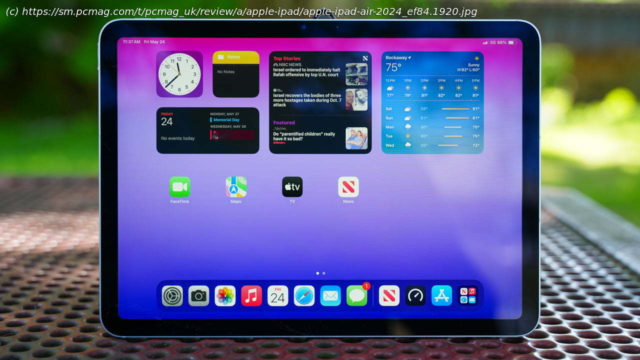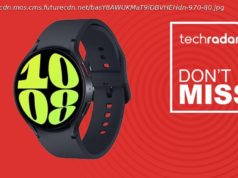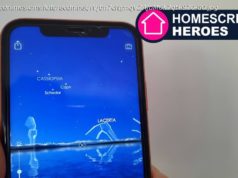The best iPad for students and casual creators
The 2024 iPad Air (starting at $599 for the 11-inch model) sits in the middle of Apple’s tablets lineup. It finds a comfortable home between the high-end iPad Pro (starting at $999) and the entry-level iPad (starting at $349). While it’s less of a leap forward than the 2024 Pro, the iPad Air gains a slightly larger display, a new processor, a relocated camera, and other spec bumps that ensure it remains the best choice for those who need more than the standard iPad can deliver but less raw power than the Pro. It’s particularly good for students and casual creators, earning it out Editor’s Choice award.Design: Familiar Hardware
Though there’s plenty of fresh tech aboard the 2024 iPad Air, it looks strikingly similar to the 2022 model. Perhaps the biggest change is that there are now two Airs from which to choose, at 11 inches ($599) and 13 inches ($799). This allows those who want a bigger screen to get one for less-than-Pro pricing. I received the 11-inch model for testing.
The smaller Air carries over the same dimensions and weight as its predecessor. The 11-inch model measures 9.74 by 7.02 by 0.24 inches (HWD) and weighs 1.02 pounds. That’s remarkably close to the 11-inch iPad Pro (9.83 by 6.99 by 0.21 inches, 0.98 pounds) as well as the standard iPad (9.79 by 7.07 by 0.28 inches, 1.05 pounds). The larger 13-inch iPad Air is bigger at 11.04 by 8.46 by 0.24 inches and 1.36 pounds. The 13-inch Air is now the heaviest of the current iPad lineup.
Comparatively, the 10.9-inch Samsung Galaxy Tab S9 FE (starting at $549.99) measures 10.01 by 6.53 by 0.26 inches and weighs 1.15 pounds.
As you would expect, the 11-inch iPad Air is the easier of the two to carry around and use. It fits into many smaller bags, while the larger one requires something bigger for transport. Neither is going to weigh you down.
Apple uses aluminum for the Air’s chassis. It forms the entire rear panel as well as the straight side edges. A large piece of glass covers the entire front of the tablet. The iPad Air doesn’t have an IP rating for protection against dust and water, while the Tab S9 FE is rated IP68 and can survive a 30-minute dunk in fresh water. If waterproofing is vital to you, you shouldn’t look to the iPad line.
The iPad Air has stereo speakers, one on each short edge, as opposed to the Pro’s quad-speaker system. It fares well when watching movies or listening to music as long as you’re holding the tablet in landscape orientation. The speakers produce more than enough volume to fill a bedroom or office. Bass response on tracks like The Knife’s «Silent Shout» is surprisingly rich.
Similar to the Pro, the iPad Air’s power button is on the left edge near the top corner and the volume buttons are on the top edge near the left corner. All three buttons work well. The power button doubles as a fingerprint reader. It works perfectly, though I recommend you take the time to register several fingerprints (at least both thumbs and pointer fingers) for the sake of convenience so you can unlock it if you happen to be holding it upside down.
C (USB 2.0) port is centered on the bottom edge. The pogo-style Smart Connector pins are nearby on the rear panel, while the magnetic connector for the Apple Pencil is on the top edge. The Air includes two microphones and a single, small camera lens on the rear panel. For cellular models, Apple nixes the physical SIM card tray and uses eSIM only.
As with the standard and Pro iPads, the Air’s front-facing camera is now centered on the top, long edge of the tablet. This means video chats look less awkward.
If you like color, you’re in luck: The iPad Air comes in Blue, Purple, Space Gray, or Starlight (goldish). The Pro is only available in Silver or Space Black.Screen: Sharp and Bright Enough
The iPad Air display doesn’t get the same glow-up as the Pro. It sticks with LED-backlit IPS LCD tech and carries over almost every spec from the previous generation.
The 11-inch model gains 0.1 inches in size but maintains the same 2,360 by 1,640-pixel resolution at 264 pixels per inch (ppi). The 13-inch model has more pixels at 2,732 by 2,048 but the same density at 264ppi. These sizes and resolutions are nearly identical to the 11- and 13-inch Pro models, but those benefit from OLED lighting tech, which produces deeper blacks and more contrast.
Both Airs are fully laminated with oleophobic and anti-glare coatings and support P3 color and True Tone for automatic white balance adjustment.






